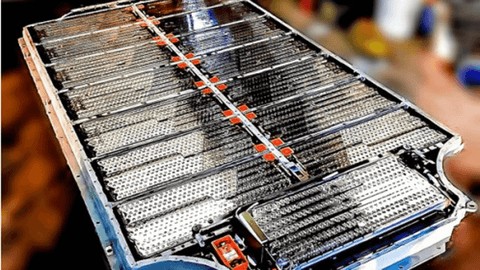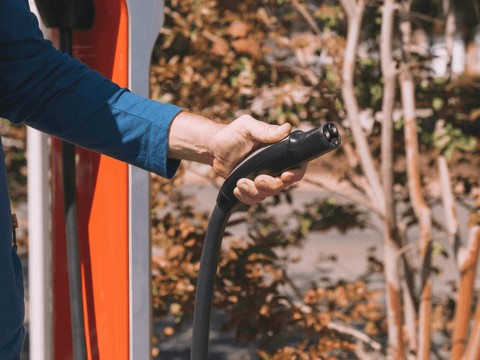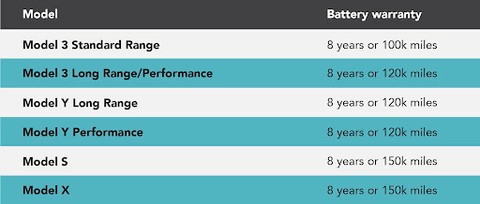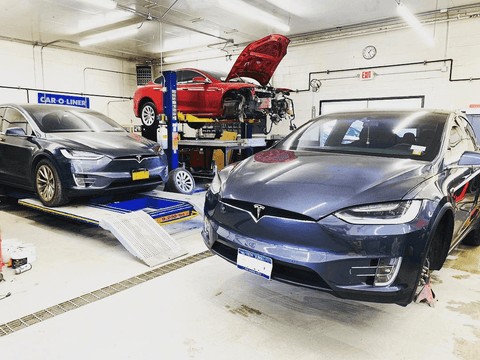How Long Does A Tesla Car Battery Last is a common question for prospective EV owners. At CARS.EDU.VN, we’re here to provide clarity on Tesla battery lifespan, degradation, and factors affecting longevity, ensuring you make an informed decision. Discover the expected lifespan, warranty coverage, and tips to maximize your Tesla’s battery health, along with insights into battery replacement costs and long-term ownership considerations.
1. Understanding Tesla Battery Lifespan and Mileage
Tesla, a leader in electric vehicle (EV) technology, estimates their batteries can last for approximately 300,000 to 500,000 miles, or around 1,500 charge cycles. While these figures are promising, understanding the nuances of battery life requires a deeper dive.
It’s essential to note that EV battery technology is rapidly evolving. Newer models boast enhanced battery management systems and improved cell chemistry, potentially outperforming older EVs in terms of longevity. Therefore, data from older EVs may not accurately represent the lifespan of current Tesla models.
For a clearer picture, let’s examine factors influencing Tesla battery lifespan:
- Driving Habits: Aggressive driving, including rapid acceleration and frequent hard braking, can accelerate battery degradation. Conversely, smooth, efficient driving extends battery life.
- Charging Practices: Frequent fast charging (Supercharging) generates more heat than Level 2 charging, potentially impacting long-term battery health.
- Environmental Conditions: Extreme temperatures, both hot and cold, can affect battery performance and lifespan. Tesla’s thermal management system mitigates these effects, but prolonged exposure to extreme conditions can still have an impact.
- Battery Chemistry: Tesla utilizes different battery chemistries in its vehicles, including Nickel-Cobalt-Aluminum (NCA) and Lithium Iron Phosphate (LFP). LFP batteries are known for their durability and longer lifespan, although they may have a lower energy density compared to NCA batteries.
Understanding these factors will help you gauge the potential lifespan of your Tesla’s battery and make informed decisions about driving and charging habits. At CARS.EDU.VN, we offer in-depth articles and resources to help you optimize your Tesla’s battery health and longevity.
2. Tesla Charging Options: A Comprehensive Guide
Charging your Tesla is simple with multiple options available. You can conveniently charge your Tesla at home, at public charging stations, or at Tesla Superchargers.
2.1 Home Charging
The majority of Tesla owners opt for home charging. The convenience of charging your Tesla overnight ensures that you start each day with a full battery. Here are the home charging options:
- Mobile Connector (120V Outlet): This is the slowest charging method, adding only a few miles of range per hour. It’s suitable for topping off the battery or for those who drive short distances daily.
- Tesla Wall Connector (240V Outlet): Recommended for faster charging, a Tesla Wall Connector can add up to 44 miles of range per hour. Installation requires a 240V outlet, typically done by a qualified electrician.
To optimize your home charging setup, consider the following:
- Assess Your Driving Needs: Determine your daily driving distance to select the appropriate charging solution.
- Consult an Electrician: Ensure your home’s electrical system can handle the increased load of EV charging.
- Take Advantage of Off-Peak Charging: Many utility companies offer lower electricity rates during off-peak hours, saving you money.
2.2 Public Charging
Public charging stations are becoming increasingly common, offering convenient charging options while you’re on the go.
- Level 2 Chargers: These chargers offer faster charging speeds than standard household outlets, adding approximately 20-30 miles of range per hour. They are commonly found at shopping centers, workplaces, and public parking lots.
- DC Fast Chargers: These chargers provide the fastest charging speeds, adding significant range in a short amount of time. Tesla vehicles can use non-Tesla charging stations with an adapter.
2.3 Tesla Superchargers
Tesla’s Supercharger network offers the fastest charging speeds, ideal for long trips. Strategically located along major highways, Superchargers can add up to 200 miles of range in about 30 minutes.
Supercharger use is straightforward:
- Locate a Supercharger: Use the Tesla navigation system to find nearby Supercharger stations.
- Plug In: Connect the Supercharger cable to your Tesla’s charging port.
- Monitor Charging: Track the charging progress on your Tesla’s touchscreen.
Understanding the available charging options allows you to plan your trips efficiently and keep your Tesla powered up. CARS.EDU.VN provides resources to help you locate charging stations, compare charging costs, and optimize your charging strategy.
3. Tesla Battery Life by Model: What to Expect
Tesla offers a range of models, each with varying battery capacities and ranges. Understanding the expected battery life for each model is crucial when making a purchase decision.
Here’s a comparison of Tesla models and their estimated battery ranges:
| Model | Estimated Range (EPA) | Battery Capacity (kWh) |
|---|---|---|
| Model 3 | 272-333 miles | 57.5-82 kWh |
| Model Y | 260-330 miles | 75 kWh |
| Model S | 375-405 miles | 100 kWh |
| Model X | 333-348 miles | 100 kWh |





Note: These figures are estimates and can vary based on driving conditions, weather, and other factors.
Keep in mind that these ranges are based on EPA testing, which provides a standardized measure of vehicle range. Real-world range can differ due to factors like driving style, temperature, and terrain.
To maximize your Tesla’s range, consider the following:
- Drive Efficiently: Avoid rapid acceleration and hard braking.
- Maintain Tire Pressure: Ensure your tires are properly inflated to reduce rolling resistance.
- Use Regenerative Braking: Take advantage of regenerative braking to recapture energy and extend range.
- Precondition the Battery: In cold weather, preconditioning the battery while plugged in can improve efficiency.
CARS.EDU.VN offers detailed reviews and comparisons of Tesla models, including battery performance analysis and real-world range tests.
4. Decoding Tesla’s Battery Warranty: What’s Covered?
Tesla’s battery warranty provides peace of mind, covering defects in materials and workmanship. Understanding the warranty terms is essential for Tesla owners.
Tesla’s battery warranty typically covers:
- Duration: 8 years or a specified mileage (100,000 to 150,000 miles), whichever comes first.
- Minimum Capacity: Guarantees that the battery will retain at least 70% of its original capacity during the warranty period.
For example, if your Model 3’s battery capacity drops below 70% within the warranty period due to manufacturing defects or workmanship issues, Tesla will repair or replace the battery at no cost.
However, the warranty does not cover:
- Normal Degradation: Gradual loss of battery capacity over time due to normal wear and tear.
- Damage from Accidents: Battery damage resulting from accidents or external factors.
- Improper Use: Damage caused by improper charging practices or neglect.
Tesla has started using Lithium Iron Phosphate (LFP) batteries in some of its cheaper Model 3 versions. These batteries are expected to be more durable and have a longer lifespan, offering a more robust option for drivers. The company also uses 12V lithium-ion batteries to power smaller components in their cars, such as lights and window motors.
To maintain your warranty coverage:
- Follow Tesla’s Recommendations: Adhere to Tesla’s guidelines for charging, maintenance, and care.
- Document Maintenance: Keep records of all service and maintenance performed on your Tesla.
- Address Issues Promptly: Report any battery-related issues to Tesla service as soon as they arise.
CARS.EDU.VN provides in-depth analysis of Tesla’s warranty terms, helping you understand your rights and responsibilities as a Tesla owner.
5. Understanding Tesla Battery Degradation: What to Expect
Battery degradation is a natural process in all rechargeable batteries, including those in Tesla vehicles. Over time, the battery’s capacity to hold a charge gradually decreases.
Several factors contribute to battery degradation:
- Age: Batteries degrade over time, regardless of usage.
- Usage: Frequent charging and discharging cycles accelerate degradation.
- Temperature: Exposure to extreme temperatures can impact battery health.
- Charging Habits: Frequent fast charging can contribute to degradation.
While battery degradation is inevitable, it’s typically a gradual process. Studies have shown that Tesla batteries retain a significant portion of their original capacity even after many years of use.
Here’s what you can expect in terms of battery degradation:
- Initial Degradation: The most significant degradation typically occurs in the first few years of ownership.
- Stabilization: After the initial period, the rate of degradation slows down.
- Long-Term Degradation: Over many years, the battery will continue to degrade, but at a slower pace.
To minimize battery degradation:
- Avoid Extreme Temperatures: Park your Tesla in the shade during hot weather and in a garage during cold weather.
- Limit Fast Charging: Use Superchargers sparingly, opting for Level 2 charging whenever possible.
- Maintain a Moderate State of Charge: Avoid consistently charging to 100% or depleting the battery to 0%.
- Follow Tesla’s Recommendations: Adhere to Tesla’s guidelines for battery care and maintenance.
CARS.EDU.VN offers resources to help you monitor your Tesla’s battery health and track degradation over time.
6. Pro Tips to Maximize Your Tesla Battery’s Life
Extending the life of your Tesla battery is possible with the right habits and practices. Here are some valuable tips:
- Use Superchargers Wisely: Reserve rapid charging for long trips when you need a quick boost. Regular use of Superchargers can generate heat, which can degrade the battery.
- Charge Smartly: Unless necessary, avoid charging the battery above 80% for daily use. Charging to 80% is usually enough and helps prolong battery life. Save the full charge for longer journeys.
- Keep a Regular Charging Schedule: A consistent charging routine helps your battery management system function optimally. Charging around the same time each day can improve battery longevity.
- Drive Smoothly: Aggressive driving, like quick acceleration and hard braking, can put extra strain on the battery. Gentle driving can extend its life.
By following these practices, you can reduce battery degradation and enjoy a longer lifespan for your Tesla battery. For more detailed guides and tips, check out CARS.EDU.VN.
7. External Factors Impacting Tesla Battery Ranges
Besides the age and condition of your Tesla’s battery, several external factors can affect its range. These factors can significantly impact how far you can drive on a single charge.
- Temperature: Extreme temperatures, both hot and cold, can reduce battery efficiency. Cold weather can limit the battery’s power output, while hot weather may require more energy to cool the battery.
- Terrain: Driving on hilly or mountainous terrain requires more energy, reducing range. While regenerative braking on downhill slopes can help, it may not fully offset the energy used for climbing.
- Payload: Extra weight, such as passengers or cargo, increases the energy needed to move the vehicle, thus reducing range.
- Tire Pressure: Underinflated tires increase rolling resistance, requiring more energy. Maintaining the recommended tire pressure improves efficiency and range.
- Wind Resistance: Strong headwinds can significantly impact range, especially at high speeds. A headwind increases aerodynamic resistance, forcing the vehicle to use more power to maintain speed.
- Regenerative Braking: Efficiently using regenerative braking can help extend range. This system captures and stores energy during deceleration, which recharges the battery.
Taking these factors into account can help you better predict and manage your Tesla’s range. CARS.EDU.VN offers resources to help you understand and optimize your driving for maximum efficiency.
8. The Cost of Tesla Battery Replacement: Factors and Considerations
While Tesla batteries are designed to last, eventual replacement may be necessary. Understanding the potential costs is crucial for long-term ownership.
If your Tesla is still under warranty, Tesla will cover repairs or replacements. However, once the warranty expires, the cost falls on the owner.
The cost of replacing a Tesla battery can vary significantly. In a tweet, Elon Musk mentioned that a replacement battery module could range from $5,000 to $7,000. It’s important to note that a Tesla battery pack comprises multiple modules.
Real-world examples have shown that Tesla owners may receive service quotes for battery pack replacements ranging from $20,000 to $30,000. This variation depends on the type of replacement needed and other factors.
| Scenario | Estimated Cost |
|---|---|
| Module Replacement | $5,000 – $7,000 |
| Full Battery Pack Replacement | $20,000 – $30,000 |
When considering a Tesla, it’s wise to factor in the potential battery replacement cost post-warranty. Planning ahead can help manage the financial implications of maintaining your electric vehicle. CARS.EDU.VN provides detailed cost analyses and resources for Tesla owners to better prepare for these expenses.
9. Exploring Alternative Battery Solutions
Beyond full replacements, alternative battery solutions can extend the life of your Tesla and manage costs effectively.
- Battery Refurbishing: Some companies specialize in refurbishing Tesla batteries by replacing degraded cells. This can be a more cost-effective option than a full replacement.
- Used Battery Market: A market for used Tesla batteries is emerging, offering lower-cost alternatives for replacements. However, it’s important to ensure the used battery is in good condition and has sufficient capacity.
- Battery Leasing: While not widely available, some companies offer battery leasing programs, allowing you to replace the battery when it degrades without a large upfront cost.
Exploring these options can provide more flexibility and affordability in maintaining your Tesla’s battery. CARS.EDU.VN offers detailed information on these alternative solutions, helping you make informed decisions.
10. FAQs: Addressing Your Tesla Battery Questions
Here are some frequently asked questions about Tesla batteries:
-
How often does a Tesla battery need to be replaced?
Tesla batteries are designed to last at least 8 years or 100,000 to 150,000 miles, as per the warranty. However, the actual lifespan can vary based on usage, driving conditions, and model.
-
How much does it cost to replace a Tesla battery?
The cost can vary widely, from $5,000 to $7,000 for a module replacement to $20,000 to $30,000 for a full pack replacement.
-
What is the life expectancy of a Tesla car?
Many Tesla owners report their vehicles lasting well over a decade with proper maintenance. The battery and drive unit warranty typically spans 8 years or a specified mileage limit, providing a guideline.
-
Is charging a Tesla cheaper than gas?
Generally, charging a Tesla is more cost-effective than using gasoline. The savings depend on local electricity and fuel prices, but electric charging is often cheaper per mile.
-
Is battery degradation a concern when buying a used Tesla?
Yes, battery degradation should be considered. The degree of degradation depends on the vehicle’s history and mileage. Checking the battery’s health before buying is advisable.
-
How far can a Tesla go on a single charge?
On average, Tesla batteries provide around 336 miles on a full charge, but it can range from 267 miles for some models to 405 miles for others.
-
What factors affect Tesla battery range?
Factors include temperature, driving style, terrain, payload, tire pressure, and wind resistance.
-
How can I extend my Tesla battery life?
You can extend battery life by using Superchargers sparingly, charging smartly, keeping a regular charging schedule, and driving smoothly.
-
What is the Tesla battery warranty?
The warranty typically covers 8 years or 100,000 to 150,000 miles, guaranteeing that the battery will retain at least 70% of its original capacity.
-
Are Tesla batteries recyclable?
Yes, Tesla batteries are recyclable. Tesla has programs to recycle and repurpose old batteries, contributing to environmental sustainability.
By understanding these FAQs, you can make informed decisions about Tesla ownership and maintenance. For more in-depth answers and guidance, visit CARS.EDU.VN.
Are you looking for reliable information on Tesla battery lifespan, maintenance tips, or repair services? Visit CARS.EDU.VN today for comprehensive guides, expert advice, and the latest updates on electric vehicle technology. Contact us at 456 Auto Drive, Anytown, CA 90210, United States, or WhatsApp +1 555-123-4567. Let cars.edu.vn be your trusted resource for all things automotive.